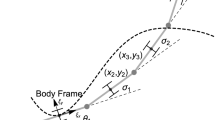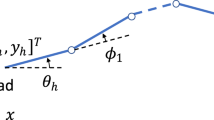Abstract
This paper presents a control method of a planar snake robot with prismatic joints. The kinematic model is derived considering velocity constraints caused by passive wheels. The proposed control method based on the model allows the robot to track a target trajectory by appropriately changing its link length using prismatic joints. The degrees of freedom of prismatic joints are represented as kinematic redundancy in the model and are used in realizing subtasks such as singularity avoidance and obstacle avoidance. In addition, the link length is below its limit when introducing a sigmoid function into the kinematic model. Simulations are carried out to demonstrate the effectiveness of the proposed method and show a novel motion that avoids singular configurations through changes in link lengths.
Similar content being viewed by others
References
S. Hirose, Biologically Inspired Robots: Snake-like Locomotors and Manipulators, Oxford University Press, Oxford, 1993.
J. K. Hopkins, B. W. Spranklin, and S. K. Gupta, “A survey of snake-inspired robot designs,” Bioinspir. Biomim., vol. 4, no. 2, p. 021001, 2009.
M. Mori and S. Hirose, “Locomotion of 3D snake-like robots-shifting and rolling control of active cord mechanism ACM-R3-,” J. Robotics and Mechatronics, vol. 18, no. 5, pp. 521–528, 2006.
S. Toyoshima, M. Tanaka, and F. Matsuno, “A study on sinus-lifting motion of a snake robot with sequential optimization of a hybrid system,” IEEE Trans. Autom. Sci. Eng., vol. 11, no. 1, pp. 139–144, 2014.
A. Crespi and A. J. Ijspeert, “Online optimization of swimming and crawling in an amphibious snake robot,” IEEE Trans. Rob., vol. 24, no. 1, pp. 75–87, 2008.
X. Wu and S. Ma, “CPG-based control of serpentine locomotion of a snake-like robot,” Mechatronics, vol. 20, no. 2, pp. 326–334, 2010.
T. Sato, T. Kano, and A. Ishiguro, “A decentralized control scheme for an effective coordination of phasic and tonic control in a snake-like robot,” Bioinspir. Biomim., vol. 7, no. 1, p. 016005, 2012.
A. Mohammadi, E. Rezapour, M. Maggiore, and K. Y. Pettersen, “Maneuvering control of planar snake robots using virtual holonomic constraints,” IEEE Trans. Control Syst. Technol., vol. 24, no. 3, pp. 884–899, 2016.
R. Ariizumi, R. Takahashi, M. Tanaka, and T. Asai, “Headtrajectory-tracking control of a snake robot and its robustness under actuator failure,” IEEE Trans. Control Syst. Technol., vol. 27, no. 6, pp. 2589–2597, 2019.
P. Prautsch, T. Mita, and T. Iwasaki, “Analysis and control of a gait of snake robot,” IEEJ Trans. on Industry Applications, vol. 120, no. 3, pp. 372–381, 2000.
F. Matsuno and K. Mogi, “Redundancy controllable system and control of snake robots based on kinematic model,” Proc. 39th IEEE Conf. on Decision and Control, Sydney, Australia, vol. 5, pp. 4791–4796, Dec. 2000.
M. Tanaka and F. Matsuno, “Modeling and control of head raising snake robots by using kinematic redundancy,” J. Intell. Rob. Syst., vol. 75, no. 1, pp. 53–69, 2014.
M. Tanaka and K. Tanaka, “Control of a snake robot for ascending and descending steps,” IEEE Trans. Rob., vol. 31, no. 2, pp. 511–520, 2015.
M. Nakajima, M. Tanaka, K. Tanaka, and F. Matsuno, “Motion control of a snake robot moving between two nonparallel planes,” Adv. Robot., vol. 32, no. 10, pp. 559–573, 2018.
H. W. Lissmann, “Rectilinear locomotion in a snake (Boa occidentalis),” J. Experimental Biology, vol. 26, no. 4, pp. 368–379, 1950.
C. Liu and W. Liao, “A snake robot using shape memory alloys,” Proc. IEEE Int. Conf. on Robotics and Biomimetics, Shenyang, China, pp. 601–605, Aug. 2004.
R. Primerano and S. Wolfe, “New rolling and crawling gaits for snake-like robots,” Proc. IEEE/RSJ Int. Conf. on Intelligent Robots and Systems, Chicago, Illinois, USA, pp. 281–286, Sep. 2014.
J. K. Hopkins and S. K. Gupta, “Design and modeling of a new drive system and exaggerated rectilinear-gait for a snake-inspired robot,” J. Mechanisms and Robotics, vol. 6, no. 2, 021001, 2014.
K. Wang and S. Ma, “Kinematic analysis of snake-like robot using sliding joints,” Proc. IEEE Int. Conf. on Robotics and Biomimetics, Tianjin, China, pp. 1484–1489, Dec. 2010.
K. Wang, W. Gao, and S. Ma, “Snake-like robot with fusion gait for high environmental adaptability: Design, modeling, and experiment,” Applied Sciences, vol. 7, no. 11, 1133, 2017.
J. Gray, “The mechanism of locomotion in snakes,” J. Experimental Biology, vol. 23, no. 2, pp. 101–120, 1946.
J. Gray and H. W. Lissmann, “Studies In animal locomotion: VII. Locomotory reflexes in the earthworm,” J. Experimental Biology, vol. 15, no. 4, pp. 506–517, 1938.
M. Takahashi, I. Hayashi, N. Iwatsuki, K. Suzumori, and N. Ohki, “The development of an in-pipe microrobot applying the motion of an earthworm,” Proc. IEEE 5th Int. Symp. on Micro Machine and Human Science, Nagoya Japan, pp. 35–40, Oct. 1994.
N. Saga and T. Nakamura, “Development of a peristaltic crawling robot using magnetic fluid on the basis of the locomotion mechanism of the earthworm,” Smart Materials and Structures, vol. 13, no. 3, 2004.
N. Saga, S. Tesen, T. Sato, and J.-Y. Nagase, “Acquisition of earthworm-like movement patterns of many-segmented peristaltic crawling robots,” Int. J. Adv. Rob. Syst., vol. 13, no. 5, p. 1729881416657740, 2016.
H. Ohno and S. Hirose, “A study of active cord mechanisms — Biomechanical consideration on its 3D gaits,” J. Robotics and Mechatronics, vol. 15, no. 4, pp. 424–431, 2003.
M. Tanaka and K. Tanaka, “Singularity analysis of a snake robot and an articulated mobile robot with unconstrained links,” IEEE Trans. on Control Syst. Technol., vol. 24, no. 6, pp. 2070–2081, 2016.
S. Nansai, M. Iwase, and H. Itoh, “Generalized singularity analysis of snake-like robot,” Applied Sciences, vol. 8, no. 10, 1873, 2018.
D. P. Martin, J. Baillieul, and J. M. Hollerbach, “Resolution of kinematic redundancy using optimization techniques,” IEEE Trans. on Robotics and Automation, vol. 5, no. 4, pp. 529–533, 1989.
M. Tanaka, K. Kon, and K. Tanaka, “Range-sensor-based semiautonomous whole-body collision avoidance of a snake robot,” IEEE Trans. Control Syst. Technol., vol. 23, no. 5, pp. 1927–1934, 2015.
M. Tanaka and F. Matsuno, “Control of snake robots -with switching constraints: Trajectory tracking with moving obstacle,” Adv. Robot., vol. 28, no. 6, pp. 415–429, 2014.
E. Rohmer, S. P. N. Singh, and M. Freese, “V-REP: A versatile and scalable robot simulation framework,” Proc. IEEE/RSJ Int. Conf. on Intelligent Robots and Systems, Tokyo, Japan, pp. 1321–1326, Nov. 2013.
Author information
Authors and Affiliations
Corresponding author
Additional information
Publisher’s Note Springer Nature remains neutral with regard to jurisdictional claims in published maps and institutional affiliations.
This work was partially supported by JSPS KAKENHI Grant Number JP18K04011.
Motoyasu Tanaka received his B.Eng., M.Eng., and Ph.D. degrees in engineering from the Department of Mechanical Engineering and Intelligent Systems, the University of Electro-Communications, Tokyo, Japan in 2005, 2007, and 2009, respectively. From 2009 to 2012, he was with Canon, Inc., Tokyo. He is currently a Professor at the Department of Mechanical and Intelligent Systems Engineering, the University of Electro-Communications. His research interests include biologically inspired robotics and dynamics-based nonlinear control. He is a recipient of the IEEE Robotics and Automation Society Japan Chapter Young Award from the IEEE Robotics and Automation Society Japan Chapter in 2006 and the Best Poster Award at SWARM2015: The First International Symposium on Swarm Behavior and Bio-Inspired Robotics in 2015.
Hidemasa Sawabe received his B.Eng. and M.Eng. degrees from the Department of Mechanical Engineering and Intelligent Systems, the University of Electro-Communications in 2018 and 2020, respectively. His research interests include the development and control of snake robots.
Mizuki Nakajima received his B.Eng., M.Eng., and Ph.D. degrees in engineering from the Department of Mechanical Engineering and Intelligent Systems, the University of Electro-Communications in 2014, 2016, and 2020, respectively. He is currently a postdoctoral researcher at the Department of Mechanical Engineering and Intelligent Systems, the University of Electro-Communications. His research interests include the development and control of snake robots.
Ryo Ariizumi received his B.Eng., M.Eng., and Ph.D. degrees from Kyoto University, Kyoto, Japan, in 2010, 2012, and 2015, respectively. He was a research fellow of the Japan Society for the Promotion of Science from 2014 to 2015. He is currently an Assistant Professor at Nagoya University, Nagoya, Japan. His research interests include the control of redundant robots and the optimization of robotic systems.
Rights and permissions
About this article
Cite this article
Tanaka, M., Sawabe, H., Nakajima, M. et al. Redundant Control of a Planar Snake Robot with Prismatic Joints. Int. J. Control Autom. Syst. 19, 3475–3486 (2021). https://doi.org/10.1007/s12555-020-0607-2
Received:
Revised:
Accepted:
Published:
Issue Date:
DOI: https://doi.org/10.1007/s12555-020-0607-2




